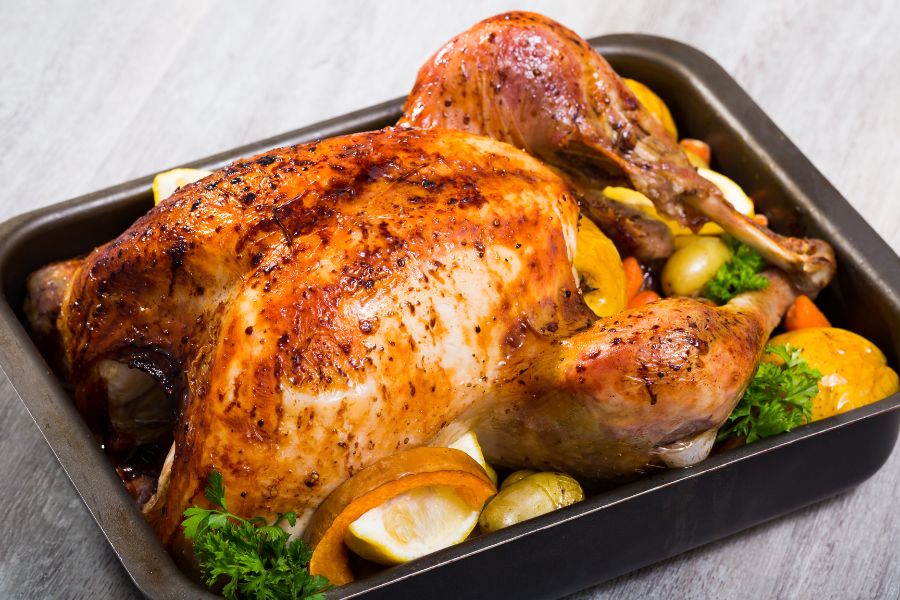Basting, were told, is simply the right thing to do. After all, if you want tender, juicy turkey meat, what better strategy than pretending your bird is in the bathtub and periodically dousing it with warm, bubbly pan juices? And yes, you did just scorch your knuckles on the third time you opened the oven door to baste. But thats a small price to pay for a Thanksgiving turkey thats as moist as slow-cooked pork belly.
Ahem. Sorry to interrupt this slo-mo basting fantasy sequence, but I cant keep down the real talk any longer. If you want juicy meat, basting the bird wont help—brining or salting it is what guarantees moist turkey. In fact, every time you baste the bird, the juices merely run along the skin rather than actually infusing the meat. Basting is for your comfort, not the turkeys.
Turns out, adding moisture is actually the last thing you want to do to your turkey skin. What you really want to do is take moisture away. See, the drier the turkey skin, the easier it crisps up. And thats what will turn your bird into a gorgeously bronze, uber-crispy trophy.
I really should have figured this out years ago. The famous Zuni Café roast chicken popularized by the dearly departed Judy Rodgers achieves incredibly juicy, crisp-skinned results by salting the bird and refrigerating it for up to three days instead of brining it. No basting required. Thomas Kellers favorite roast turkey has you brine the bird for a day, then air-dry it for another day to achieve that dry skin before roasting. Once again, no basting, and ridiculously juicy, crispy results.
As Thanksgiving approaches, home cooks everywhere are debating whether or not to baste their turkeys this year. Basting is the process of spooning or brushing juices, butter, or oil over the turkey periodically as it roasts. This technique has long been touted as the secret to a moist, juicy, and flavorful holiday bird. However, some modern experts argue that basting is an unnecessary or even counterproductive step. So should you baste your turkey or not? There are good arguments on both sides of this debate. Here is a detailed look at the pros and cons of basting, so you can decide for yourself whether or not to include it in your Thanksgiving turkey prep.
What Is Basting and Why Do People Do It?
Basting a turkey involves opening the oven periodically during roasting and spooning pan drippings, melted butter, or oil over the turkey. The goals are to prevent the white meat from drying out, improve flavor, and crisp up the skin. As the turkey roasts, juices collect in the bottom of the roasting pan. Basting allows you to scoop those flavorful juices up and redistribute them over the breast meat. The fat in the pan juices also promotes browned, crispy skin. For generations, basting a roasting turkey every 30 minutes was considered essential for a picture-perfect holiday centerpiece. Cookbook authors and TV chefs touted basting as the key to succulent, golden results.
The Case For Basting: Potential Benefits
-
Prevents Dry White Meat: Basting moisturizes the turkey breast, preventing it from drying out before the dark meat is fully cooked. The juicy pan drippings essentially slow down the cooking process for the quicker-cooking breast meat.
-
Promotes Crispier Skin Basting with fatty pan juices or butter helps the skin brown and crisp up The fat will caramelize, creating that gorgeous mahogany sheen.
-
Enhances Flavor Basting infuses the turkey with concentrated, savory meat juices These juices pick up aromatics from herbs in the cavity and under the skin. Basting ensures turkey flavor in every bite
-
Delicious Pan Sauce: Leftover basting liquid makes a simple, flavorful gravy or sauce to serve with the carved turkey. Skim off excess fat and stir the defatted drippings into your gravy.
-
Time-Honored Tradition: For many home cooks, basting the turkey is an integral part of the Thanksgiving experience. The ritual just wouldn’t feel complete without pausing to baste between kitchen tasks.
Reasons to Avoid Basting Your Bird
-
Minimal Improvement to Moisture: While basting provides surface moisture, it does not actually penetrate or flavor the meat. Brining, salting, or stuffing butter under the skin are better ways to guarantee a juicy interior.
-
Slows Browning: Opening the oven repeatedly drops the temperature and prevents the turkey from browning properly. It can add a significant amount of time to the overall roasting.
-
Makes Skin Soggy: Rather than crisping the skin, basting can make it slimy and soft. For crisp skin, thoroughly drying out the skin before roasting is key. Excess moisture is the enemy of crispy.
-
Messy Process: Basting can be awkward and messy, especially if you don’t have a proper turkey baster. Spilling hot drippings or burning your fingers is no fun.
-
Not Necessary: As long as you don’t overcook it, your turkey can turn out perfectly moist and delicious even without basting. It’s an optional technique, not a requirement.
How to Baste a Turkey if You Decide to Do It
If you elect to baste your turkey this Thanksgiving, here are some tips for the process:
-
Use a turkey baster or large spoon to collect drippings. Tilt pan and spoon from the pooled corner to avoid burning.
-
Open oven quickly to prevent heat loss. Remove roasting pan, then shut oven immediately.
-
Work fast to coat bird evenly, then return pan to oven ASAP.
-
Baste every 30-45 minutes. Don’t do it too often or the bird won’t brown.
-
Use butter or oil for crisper skin in the last hour.
-
Make gravy from the leftover flavorful basting liquid.
The experts seem divided on whether basting is an essential technique or just an unnecessary hassle. There are compelling arguments on both sides. Basting certainly produces a beautiful, moist turkey, but it is also messy and time-consuming. Ultimately, the choice comes down to your Thanksgiving turkey priorities and traditions. If presentation matters above all, basting can help achieve magazine-worthy results. However, if convenience is more important, your turkey will still turn out tasty and juicy even without basting. Whatever you decide, just be sure not to overcook the turkey, and you are guaranteed to have a delicious holiday centerpiece this Thanksgiving!

Slather the turkey with clarified butter, not the regular kind
If you cant resist the urge to give your bird a coating of something delicious, follow Kellers lead and try clarified butter instead of the regular melted kind. The couple minutes it takes to spoon the foam off the melted butter and pour off that clear, golden butterfat is more than worth it. Clarified butter doesnt have any water in it, so its ideal for promoting the crispiest skin. (You know what else is good for promoting crispy skin? Mayo.)
Air-dry your turkey before you roast it.
Whether you choose brining or salting (also called “dry brining”), youll want to let the skin of your turkey thoroughly air-dry before you put it in the oven. Take the turkey out of its brine–or the brining bag youve been salting it in—and pat the turkey dry with paper towels. Then place it on a flat rack (or a couple layers of paper towels) on a large rimmed baking sheet and let it sit in your refrigerator for at least 8 hours (or overnight).
“Should I Baste My Turkey?” We Find Out Once and For All If Basting a Turkey is Necessary
FAQ
Should I rub butter or oil on my turkey?
However, butter is about 17 percent water, and it will make your bird splotchy, says López-Alt. Instead, rub the skin with vegetable oil before you roast.Nov 23, 2015
When should I start basting the turkey?
When Should You Baste Turkey A good rule of thumb is basting your turkey every 30-45 minutes, no matter the size of your delicious bird. Opening the oven, grill, or smoker will result in a loss of heat so you want to make sure you don’t baste more often than this.
What should I baste my turkey with?
As basting is all about distributing fat and flavor to be locked into the turkey, a compound butter—rubbed under the skin before transferring into the oven—is …Sep 12, 2023
